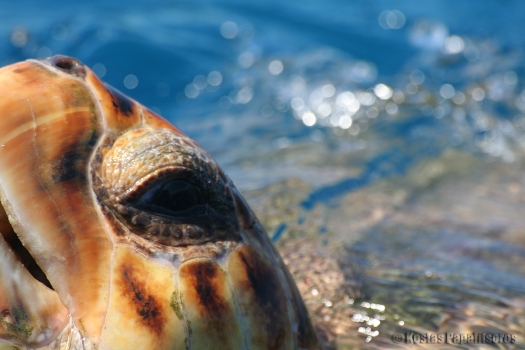I will start straight with an example. Consider the following two photos both of which were taken in Laganas Bay, Zakynthos, Greece:


In the first photo we can see some people observing a sea turtle which is calmly swimming in the sea. On the contrary, in the second photo we can see a totally panicked turtle who is desperately trying to escape from the people that are trying to observe her.
So everything right so far, we have nothing to discuss about. Apart from the fact that you have just been deceived! Actually the correct descriptions of the photos were reversed! In the first photo while the two snorkelers were keeping a fair distance to the turtle, she was accelerating her pace, swimming away, being totally uncomfortable with the human presence. In the second photo, the juvenile loggerhead (named “George”), after taking a breath, he dived again down to the bottom of the sea and he continued foraging calmly (at least judging from external movement signs) despite all the high number of snorkelers that were above him. Needless to say, these aggregations are to be avoided as other turtles might not have this kind of response – see one of the previous posts for a comprehensive analysis on that.
What I have just done is that I took advantage of your confirmation bias as well as other aspects of human psychology that can lead to false conclusions. You might be aware of the negative effects of humans on sea turtles. You might also be aware that I have a certain experience on human-turtle underwater interactions, so you have no reason to doubt me. The second photo is taken in such a way that it creates a range of negative emotions towards the swimmers and empathy for the turtle. So most likely you will accept my first description without second questions. As a photographer I have the power to use my photos to manipulate your emotions and I can do that very easily.
The use of emotions is essentially the main tool of conservation photography and I am not saying that I am against it, I also do it all the time. Problems arise though when this tool is abused and on the way to create these emotions, facts are neglected or altered. I have seen that be done many times but I will mention here two recent examples that came to my attention.
The first concerns this photo of a “pixelated” green turtle, which is part of a similar series of photos of other species (shared on Facebook 36000 times as of October 11, 2019). The claim is that the photos “are composed of as many pixels as the numbers of individuals of these species still alive in the wild!”. This means that the photo claims that about 6000 green turtles are alive in the wild. To put that into perspective, the number of Mediterranean loggerheads is estimated to be around 0.81−3.38 million [source]. The number of loggerhead nests in the Mediterranean in a year is around 8000 [source]. It is safe to say that the number of green turtle nests worldwide is at least 10 times that number. One only has to take account the main rookeries for the species. With very rough and conservative estimates we can say that the number of green turtles alive in the world (not only adults but of all age classes) is in the order of tens of millions. However, non-knowledgeable internet users have no reason to doubt the number 6000, given how much hyped is the combination of the words “sea turtle” and “extinction”. Note that scientists of the Marine Turtle Specialist Group (the global authority on sea turtles) also pointed out that huge inaccuracy, however there were no corrections on the photo caption so far.
The second example, concerns this photo of a turtle eating a plastic bag. The photo is widely spread online and also featured in the website of one of the most famous and oldest environmental organisations. However, the photo is photoshopped as they are many in the photo account of the photographer. Here for instance, you can see, what it seems to be, the original photo. Note that the fact that the photo is photoshopped is essentially never mentioned (I wonder if I am the first one to point that out…). Again we have no shortage of scientific works that report plastic ingestion from turtles, so there is no apparent reason to doubt that originality of that photo at a first glance.
It is very likely that the above two were simply mistakes. However, mistakes like that undermine the rigorous works of scientists – in these cases – the ones who are trying to estimate wildlife populations and assess the impact of humans on animals. It also shows that in a world with increasing (?) environmental problems, and a overflowing of relevant information, people can be very easily made to believe whatever is depicting something which is in accordance with this information – confirmation bias and also availability heuristic.
Closing, I would like to stress one more time that conservation photography is about emotions and not facts. And this is fine. I am not even saying that decisions regarding conservation should not take account any emotions. However further critical thinking is always required in order to judge a complex situation as typically a single photo is not enough for this.

